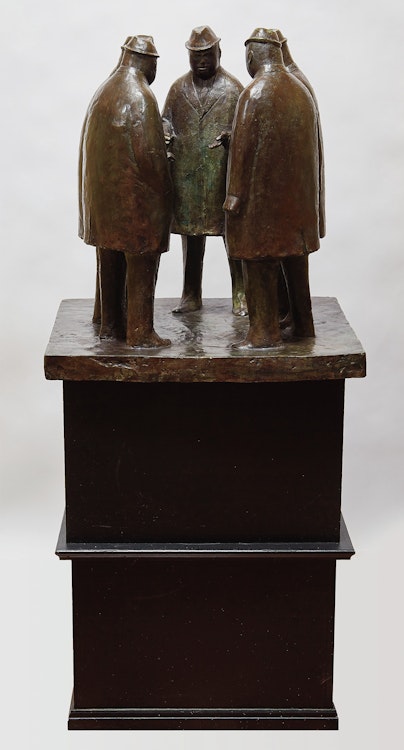Businessmen in Discussion by William Hodd McElcheran

William McElcheran
Businessmen in Discussion
bronze
sold with custom built wooden pedestal
20.75 x 16.75 x 19.75 ins ( 52.7 x 42.5 x 50.2 cms ) ( overall (excluding wooden pedestal) )
Auction Estimate: $15,000.00 - $20,000.00
Price Realized $28,800.00
Sale date: November 22nd 2021
Collection of Leon Katz, Toronto
Private Collection, Toronto
Ed. Inge Lindemann, “William Mac (William McElcheran): The Businessman”, Toronto, 1991, pages 26- 28 and 31
Kinsman Robinson Galleries, “William McElcheran: Humanism in Bronze” [exhibition catalogue], Toronto, 2010, pages 2-6
The distillation of the figures in classic bronze holds a timeless quality, transcending trends and maintaining their human warmth. In this work, the five men are circled in discussion, each taking on their own unique postures and mannerisms and have been captured in a moment of animated conversation. The unofficial Bay Street uniform of suits and ties, overcoats, top hats, and briefcases adorn the men and create contemporary archetypes of the modern non-hero. The men are characterized in a cheeky portly manner in what the artist described as the image of “the anti-ideal”, a contrast to the traditional athletic physiques of classical sculptures of mythical heroes.
Share this item with your friends
William Hodd McElcheran
(1927 - 1999)
Born in Hamilton, Ontario, he attended the Central High School under Hortense and John Sloan Gordon. He then studied sculpture at the Ontario College of Art under Emanuel Hahn and graduated in 1947, winning the Lieutenant-Governor’s Medal. He worked as a designer of church furniture for the Valley City Manufacturing Company, Dundas, Ontario (1950-55) and then settled in Toronto, where he became a chief designer for a Toronto architectural firm. He did designs for St. Stephen’s Church on the Mount, and McMaster Divinity College, Hamilton, and other churches (1955-61). Subsequently, he was able to work on his own and received a Canada Council grant in 1969-70. He also did decorations for St. Theresa’s, St. John’s Newfoundland, and the Augustinian Monastery, King, Ontario. He was artist in residence at St. Augustine Seminary, Scarborough, Ontario.
His sculpture “The Race” (a group of children running) was shown at the Canadian sculpture show organized by Dorothy Cameron and sponsored by the National Gallery of Canada and on the site of the new Toronto City Hall in 1967. This work was part of a series he was doing concerned with the shape of groups of people. By 1969, he was exhibiting at the Roberts Gallery, Toronto, and was described by Ms. Cameron as follows, “The art of William McElcheran is concerned with the irony and paradox of modern life; with the comedy of the commercial rat-race and the seriousness of play; with the dilemma of remaining ‘uselessly’ human in this computer age; and with life itself as an ultimate ball game for the survival of the soul. We, the players, are treated with a neat blend of tender satire, compassion and infinite hope.”
Subsequently, he exhibited at the Art Gallery of Hamilton in November of 1969 and the show was warmly reviewed by Paul Duval. A retrospective showing of his work followed at the Arts and Letters Club, Toronto, and a one-man show at the Roberts Gallery, Toronto, in May of 1971, featuring his polyester reliefs, bronze reliefs, and sculpture in bronze, stone and teak. Kay Kritzwiser, writing about the show, remarked, “McElcheran has steeped himself in the graphic information revealed by ancient Assyrian bas reliefs, where the role of every person was identifiable by posture or raiment. ‘You knew who everyone was – king or peasant. But I see the crowds on our street as a mass. They may be Bay Street executives, clothing salesman, or a big developer – you can’t tell. We don’t know who our kings are. We hide the power’…. Throughout McElcheran’s huge body of work (three galleries full) run similar references to ancient culture. But his people are contemporary, cloaked in frightening sameness, marching sheep-like on the streets, up the escalators, into stadiums…. McElcheran revels in the new freedom for expression he finds in relief sculptures, even if it’s something of an indulgence…. Relief is not compressed sculpture, McElcheran says. He sees it as a raised drawing, a three-dimensional presentation of drawing and design.”.
His “On the Boardwalk”, a wooden sculpture (of a plumb woman in a bathing suit) was exhibited at the Royal Canadian Academy’s 90th Annual Exhibition, 1970, and reproduced in the exhibition catalogue. From a taped interview with Dorothy Cameron for the Toronto City Hall exhibition catalogue, McElcheran explained, “For thousands of years artists have painted, modelled and carved the human form. I am thankful for this spadework, but I am not going to stop now and say that nothing more can be down with this infinite theme. The Greeks lived before Freud; the Renaissance came before Darwin. Today we have something else to say about man! The artist is one of the few people who still have the freedom to choose. In the face of fifteen thousand years of human thought, out of the confrontation of this vast environment of human creativity, he has the power to choose what he loves and infuse it with his own spirit.”
Source: "A Dictionary of Canadian Artists, Volume 4: Little - Myles", compiled by Colin S. MacDonald, Canadian Paperbacks Publishing Ltd, Ottawa, 1978

